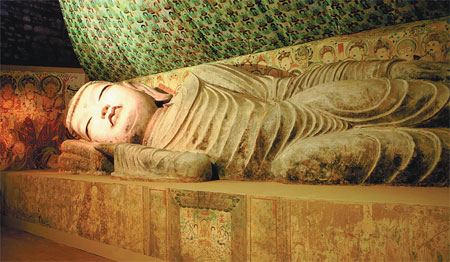當前位置: Language Tips> 新聞播報
分享到
Visitors to Istanbul between now and early 2013 can savor China's rich history through two exhibitions, Harvey Dzodin reports.

A reproduction of the famed Nirvana Reclining Buddha of Dunhuang, from the Tang Dynasty, can be seen in Turkey's capital. Provided To China Daily
Istanbul has to be one of the most exotic and fabled cities in the world. And now two of its iconic buildings are sharing history's stage with two exceptional exhibitions from China. Recognizing the growing importance of bilateral relations, Chinese and Turkish officials designated 2012 as the Year of Chinese Culture in Turkey and 2013 as the Year of Turkish Culture in China. Those lucky enough to be in Istanbul are the beneficiaries of this modern day cultural reconnection of the ancient Silk Road.
Topkapi Palace is one of the city's most famous landmarks. Strategically situated on a promontory jutting into Marmara Sea, it is reached by walking past storied mosques, an Egyptian column, annoying carpet merchants and what used to be a Roman Hippodrome.
Topkapi's Treasury contains a collection of some of the best Chinese porcelain outside of China, as well as priceless items such as the Prophet Muhammad's sword and cape.
A cobblestone path leads to the Treasures of China exhibition, housed in the Has Ayilar, where visitors will be able to see for themselves four of the first emperor of China Qin Shihuang's Terracotta Warriors, plus a horse, the latter of which has never been shown outside China.
It is so lifelike that it is easy to imagine it going for a gallop, nostrils flaring.
Among the other treasures on show are delicate porcelains and stone carvings.
Representing 5,000 years of China's rich history, Treasures of China draws on works from 11 of China's top cultural institutions, including the Palace Museum, Shanghai Museum and Qin Shihuang Museum. The show will continue until Feb 23.
The second ongoing exhibition lies across the river known as the Golden Horn, in another of Istanbul's storied buildings, the Tophane-i-Amire, built more than five centuries ago.
The original purpose of this high-walled, multi-domed and majestic edifice was to manufacture cannons, the high-tech weaponry of the era. Nowadays, in peaceful times, it serves as an exhibition area for the nearby Mimar Sinan Fine Arts University.
Colors of Dunhuang presents the UNESCO World Heritage site on the Silk Road in Gansu province, home to the world's best-preserved and largest ancient Buddhist art site, which features the sacred Mogao Grottoes.
As the exhibit clearly explains, starting in the 4th century the caves were used for meditation by monks, but later became a place of worship and pilgrimage for the general public.
While, by necessity, the exhibition consists of mostly well-executed replicas, it is a moving experience nonetheless.
Two of my favorite installations were the monumental 13.5 meter, serene sleeping Buddha at the very back of the exhibition, as well as audio exhibits available on headphones, of ancient Chinese musical instruments.
There was also a "participatory area", where people happily recreated their own cave drawings and shared them with friends. The exhibition runs up to Jan 7.
Treasures of China and Colors of Dunhuang have been expertly organized by the China Arts and Entertainment Group, on behalf of the Chinese Ministry of Culture, as well as the Turkish Ministry of Tourism and Culture.
Next year it's Turkey's turn to present the richness of its culture to the people of China.
The author, Harvey Dzodin, is a senior adviser to Tsinghua University and former director and vice-president of ABC Television in New York.
Related readings
Little hope for gun control in US
Those helping others need protection
(中國日報網英語點津 Helen 編輯)
分享到
關注和訂閱


電話:8610-84883645
傳真:8610-84883500
Email: languagetips@chinadaily.com.cn